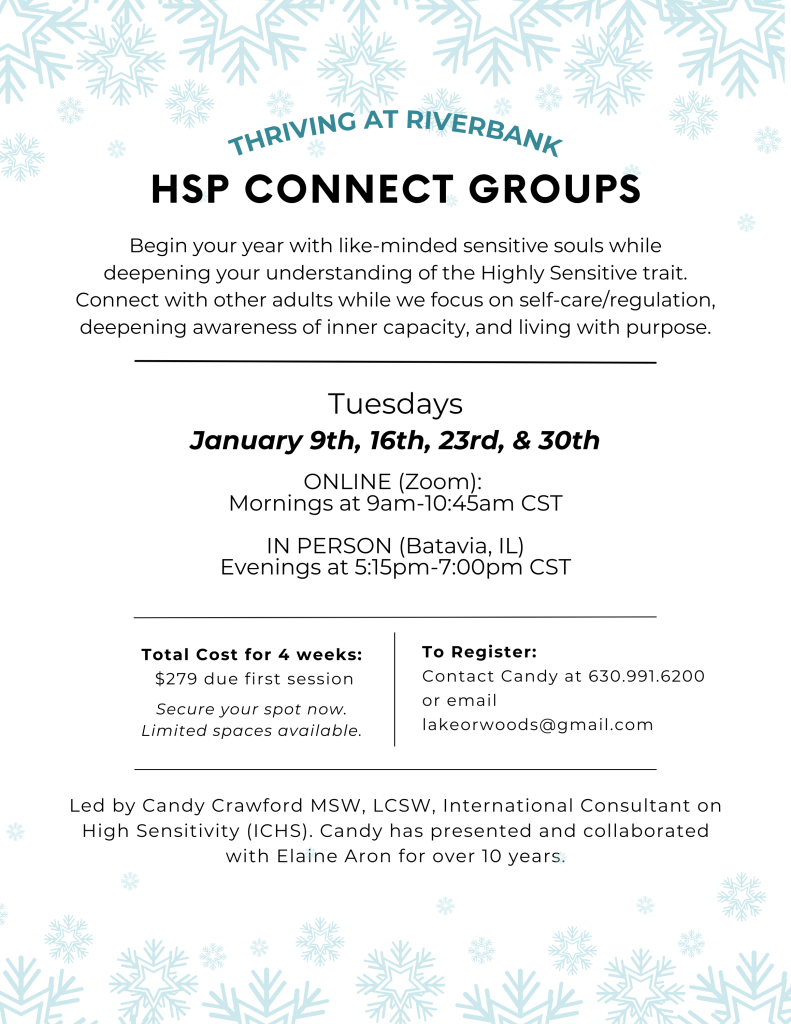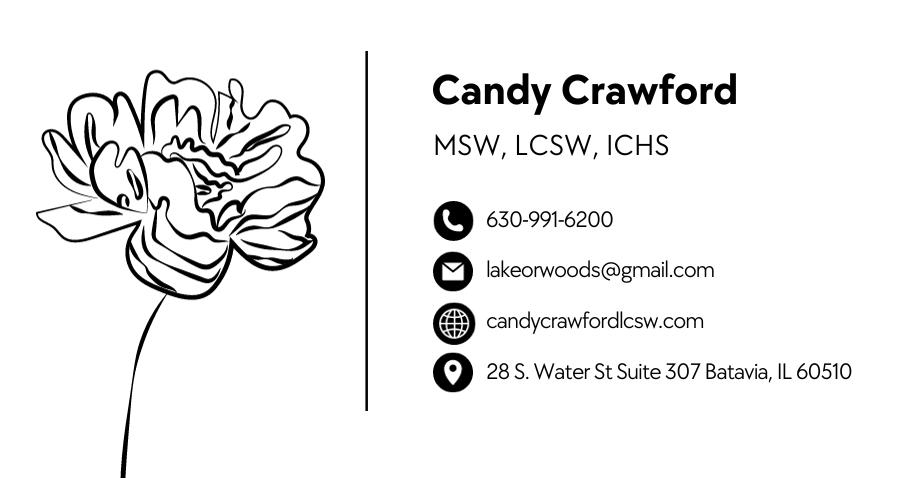Vibrant Days…
Flourishing with Sensory Processing Sensitivity
December 2023
Greetings dear friends, I’m praising the quiet of the moment. Why do I feel victorious that I discovered silence in December?
Each December my brain compiles a “best of list” of being highly sensitive. It’s a list in progress. It’s strange how I’m often aware of a silent grudge that I’m so sensitive in the first place. I’ve had three people recently say, “Candy that’s right, you are such a strong feeler.” Why do these comments sting? Need more time to alter the way I see something like that. It’s also strange that the more I’m in touch with my capacity to feel the more it feels like a gift.
We all need places to show up in our sensitive selves and feel the freedom and satisfaction of being who we are. This often happens when I lead Riverbank groups. I begin this month’s newsletter with some words from someone who participated in a recent group.
As we venture ahead into this sometimes stress filled season may your trait direct your focus to things that are tender, soothing and true.
With you in spirit,
Candy
Thriving at Riverbank

The Mystical Practicality of ‘Thriving at Riverbank’
Thriving at Riverbank is an educational support group for highly sensitive people.
Doesn’t that sound awful?
Let’s try this again. Imagine a grove of stately oaks backed up to a deep, flowing river. All around are millions of creatures – large and small – who flourish under the protection of the trees and water. Small beneath the canopy of leaves, a group of human guests enjoy the company of geese and squirrels, the deep rush of the river, and a scented breeze. These humans are keenly attuned to their natural hosts and to each other. Their conversation ebbs and flows like the river, is infused with laughter and tears, and is without shame. A kind, committed sage offers insight, empathy, and guidance as the group explores new territory and relearns old truths. The time they have together is both a minute and an eternity; each member traversing their own galaxy within the safety of the others. As the journey closes, the small community disbands – exhausted, renewed, and profoundly grateful for the kinship of their peers and the wisdom of their guide.
In less mystic terms, Thriving at Riverbank is designed to bring highly sensitive people together for HSP-specific learning in a space that is safe and encouraging of personal exploration. The group nature of the Thriving sessions offers mutual support, encouragement, and challenge.
Though Thriving carries the somewhat intimidating label of “psychoeducation”, each lesson on the trait of High Sensitivity is insightful, encouraging, and enjoyable. The monthly sessions and individual meetings have their own focus, and the enriching conversation flows with the needs of the group. The Thriving topics include foundational HSP principles, the nuances of relationship for HSPs, and even holiday survival techniques.
Thriving’s founder, HSP expert Candy Crawford, is a skilled educator. Her intuitive style supports group members’ inquiry and application of presented material in a gentle, personal manner. Hosted both in-person and online, Thriving participants will find themselves warmly welcomed, fully accepted, and insightfully challenged.
Though the process of self-discovery may feel like an epic quest, Thriving offers sojourners a clear map, the fellowship of equally brave companions, and the support of an experienced guide.
Sign up today!
New resource for hsps!
Ask Alane: Why Do I Worry So Much and How Can I Stop?

Sensitive people were designed to think. A lot. But where is the line between deep thinking and excessive worrying?
This is the first installment of Sensitive Refuge’s new advice column for highly sensitive people. Our resident advice columnist is Alane Freund, one of the world’s top therapists for HSPs. Alane has been trained by and worked closely with Elaine Aron, and is here to help you sort out your life conundrums as a sensitive person. Submit a question to Alane here.
Dear Alane, My daughter and I are both highly sensitive and we always have something to worry about. I feel like I can’t help her with her worry because I don’t even know how to deal with my own! I wish we could just turn both our brains off and stop thinking so much about every little thing. How can I help her (and help myself!) to worry less? —Always Worrying
Dear Always Worrying,
First things first. Worry is our birthright as highly sensitive people. We see it in the youngest among us. I would say it’s a feature and not a bug of our deeply processing brains, but honestly, it can be both!
For example, I remember standing on the high diving board at the public pool as a tween. I can still feel the pressure of the line of kids waiting and jeering as I stood frozen, staring at the water beyond my toes. It wasn’t that I was scared (well, maybe I was a little), I just needed to pause and think before going literally overboard. I just needed a bit more time and a little less pressure – two things kids impatiently awaiting their turns rarely extend.
We sensitive ones were designed to think. A lot. But where is the line between thinking and worrying? And why do some of us cross the line and get lost on the wrong side of it?
And, AW, you’re a parent. Parents become even bigger worriers when our children worry. It can be a tricky cycle — even a self-fulfilling prophecy. But it may be helpful to know we come by our honestly, as do most animals, even flies and fish. Worrying is baked into how nature built our brains.
Nature Made You Worry for a Reason
There are two basic strategies for how people (and animals) behave in the world, particularly in responding to their environment. In fact, in a 2008 study, biologists documented these same two strategies in over one hundred species.
So what are the two strategies?
The first one is to just go for it — and if it doesn’t work, go for it again.
The second one is to do it once and do it right.
Scientists refer to the “just go for it” strategy as a nonresponsive, impulsive, or non-sensitive reaction. It doesn’t take much into consideration, nor does it scan the circumstances and evaluate the best course of action. Instead, it’s opportunistic. It perceives a possible, positive outcome, and it pursues it, and it often pays off. (Thank goodness most people are like this so things get done!)
In contrast, the second strategy is called a responsive, reflective, reactive, or sensitive reaction. This strategy takes advantage of processing the information at hand. It charts a course of action based on all the known facts, hoping to maximize the outcome and minimize the risk. This is what sensitivity researcher Elaine Aron calls the “pause-to-check” response — and it’s a central feature of a highly sensitive person’s brain. Basically, we sensitive people want to get things right the first time. We are careful and deliberate about our actions. And thank goodness humanity has us here thinking more carefully (and hopefully advising the go-for-it majority).
I utilized my ‘pause-to-check’ response on the diving board all those years ago. And, although diving boards are mostly safe, this same response can often make a life-or-death difference.
Scientists have observed this in a remarkable range of species. I love the example of the Pumpkinseed Sunfish, which one study labeled as either “bold” or “timid” when a new trap was set in their pond. Many of the fish boldly swam right into the trap, but a smaller number hesitated before swimming, presumably detecting that there was something new in their environment. From my perspective, the “timid” fish looked pretty smart. Their pause to respond to the environment kept them safe.
So, far from being a hindrance or shortcoming, the “pause to check” response is actually evidence of a sensitive person’s subtle perception and depth of processing. As highly sensitive people (HSPs), our more reactive brains make us more aware of physical subtleties, more emotionally tuned in, and more thoughtful about it all — which Elaine Aron and I esteem as emotional leadership. Emotional leadership means leading with your emotions and empathy, but it also means you will have emotional responses before those who are less sensitive — often the same emotions others might have but take longer to access. You can and should draw from these strengths to advise the more impulsive people in your life and guide those around you to wise action.
But the “pause to check” response comes with a byproduct: worry. Sometimes even unnecessary worry. Not every pond has a trap in it, but the HSP mind is inclined to check every pond just in case. And that can become very frustrating if it turns into constant worry — or seeing your sensitive child worry.
So, AW, how do you make the worrying stop? It starts with changing the way you interact with your deep processing — and transforming the worry into something useful.
Song I have on repeat:
What I’m pondering:
Where do we lose ourselves time and time again?
Silent and holy the night.
Does it take that much to honor the movement of love? Isn’t the evidence everywhere, if only we’d take it in? If only we’d let love turn something around inside of us?
Silent and holy the night.
We could stop. We could refuse to go a step further until we have remembered the love and praised the holy, until we feel their force again-not dimly, in the background of our continuous activity, but strongly, purely, deeply, truly. We could refuse to go a step further until we are once again connected to what’s holy— our bearer of love. It’s possible to stop the insane rushing and the weight of our schedules.
Silent night. Holy night.
Paula D’Arcy


